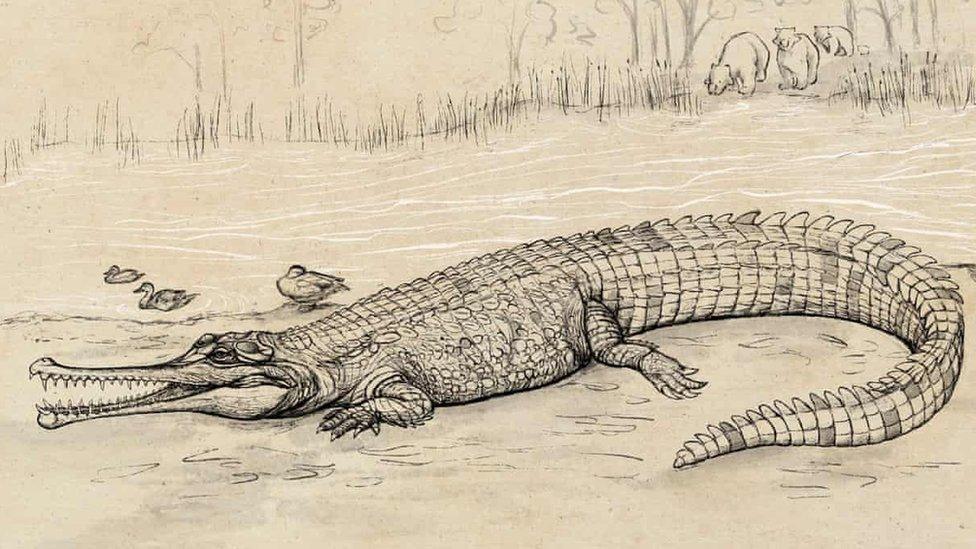Meet the GIANT prehistoric 'river boss' croc!
- Published
- comments

An artist's representation of Gunggamarandu maunala, a prehistoric crocodile also known as 'river boss'
What's really, REALLY old, incredibly large, and covered in scales...?!
The prehistoric 'river boss' crocodile of course!
The fossil of the Gunggamarandu maunala was discovered in Queensland, Australia back in the 19th century - over 100 years ago! But it's taken until now for its secrets to be revealed.
Read on to find out more amazing facts about this ancient beast!
What else do we know?
Jorgo Ristevski from the University of Queensland holds the fossilised skull
Gunggamarandu means 'river boss' and maunala means 'hole head', referring to the openings on the top of the crocodile's skull.
These words are from the languages of the First Nations peoples from the region the fossil was discovered - what is now Queensland, Australia.
The river boss croc would have once roamed the waters in south-east Queensland and is believed to have grown up to seven metres long. It is thought to be the largest crocodile to have lived in Australia.
Jorgo Ristevski, a PhD candidate from the University of Queensland's school of biological sciences, says it's difficult to estimate the exact size of the crocodile, as researchers only have the back of the skull.
"But it was big," said Ristevski, who led the research team. "We estimate the skull would have been at least 80cm long and, based on comparisons with living crocs, this indicates a total body length of around seven metres."
The fossil is thought to be up to 5 MILLION years old!
Why did it take so long for the fossil to be analysed?
Researchers created a digital 3-d version of the skull
The piece of skull was discovered in about 1875, but researchers have only just identified that it belongs to the river boss.
"Since its initial discovery, the skull was kept safe in the collection of the Queensland Museum, although it didn't reveal its secrets for over a hundred years," palaeontologist Dr Steven Salisbury said.
Researchers digitally reconstructed the skull using CT scans to learn more about the anatomy of the crocodile's brain.
"That can now be used by other scientists for comparisons with other extinct crocodilians from around the world," Ristevski said.
What did the scientists discover?
The black star on this map of Australia indicated the Darling Downs region, where the river boss fossil was discovered
The team revealed that the new species belongs to a group of crocodilians called tomistomines.
Australia was previously the only continent other than Antarctica without fossil evidence of tomistomines - until now.
Ristevski said: "But now we have evidence of this lineage here as well, since Gunggamarandu is the first tomistomine discovered in Australia. As such, Gunggamarandu is distantly related to the living Australian crocs as well as all other extinct crocs from Australia known to science."
Scientists are still not certain how the species became extinct but one theory is "it's very likely related to the gradual drying of the Australian continent over the last few million years, and in particular over the last few 100,000 years," Salisbury said.
"The big river systems that once supported crocs like this have long since dried up from south-east Queensland, and with them so have the crocs."
What do you think of the giant river boss croc? Let us know in the comments below.
- Published15 June 2021
- Published11 June 2020
- Published12 August 2020
